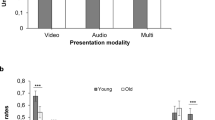Abstract
Isaacowitz and Stanley review age differences in facial emotion recognition, an ability tied to effective socioemotional functioning but often marked by age-related decline. They highlight major findings from the past decade and conclude that age-related declines exist but are least pronounced for positive relative to negative emotions. They discuss possible motivational and structural explanations for this positivity effect, and they describe future research avenues for evaluating age-related differences in more ecologically valid contexts. In this commentary, we discuss each of these topics. We state that many complexities that arise when interpreting age differences are similar to issues raised by emotion scholars who have studied intrapersonal and interpersonal processes outside of the developmental literature. We argue that theoretical and methodological lessons gained from these emotion scholars would provide insight to interpret current findings and direct future research in life-span development.
Similar content being viewed by others
References
Almeida, D. M. (2005). Resilience and vulnerability to daily stressors assessed via diary methods. Current Directions in Psychological Science, 14, 64–68.
Campos, B., Schoebi, D., Gonzaga, G. C., Gable, S., & Keltner, D. (2011). The interpersonal primacy of positive emotion. Manuscript under review.
Carstensen, L. L. (1992). Social and emotional patterns in adulthood: Support for socioemotional selectivity theory. Psychology and Aging, 7, 331–338.
Carstensen, L. L., Fung, H., & Charles, S. T. (2003). Socioemotional selectivity theory and emotion regulation in the second half of life. Motivation and Emotion, 27, 103–123.
Charles, S. T. (2010). Strength and Vulnerability Integration (SAVI): A model of emotional well-being in later adulthood. Psychological Bulletin, 136, 1068–1091.
Charles, S. T., Piazza, J., Luong, G., & Almeida, D. M. (2009). Now you see it, now you don’t: Age differences in affective reactivity to social tensions. Psychology and Aging, 24, 645–653.
Ekman, P. (2001). Telling lies: Clues to deceit in the marketplace, politics, and marriage. New York: W.W Norton.
Ekman, P., Friesen, W. V., O’Sullivan, M., Chan, A., Diacoyanni-Tarlatzis, I., Heider, K., et al. (1987). Universals and cultural differences in the judgment of facial expressions of emotion. Journal of Personality and Social Psychology, 53, 712–717.
Fingerman, K. L., & Charles, S. T. (2010). It takes two to tango: Why old people have the best relationships. Current Directions in Psychological Science, 19, 131–137.
Haidt, J., & Keltner, D. (1999). Culture and emotion: Multiple methods find new faces and a gradient of recognition. Cognition and Emotion, 13, 225–266.
Hawkins, M. W., Carrere, S., & Gottman, J. M. (2002). Marital sentiment override: Does it influence couples’ perceptions? Journal of Marriage and Family, 64, 193–201.
Isaacowitz, D. M., Löckenhoff, C. E., Lane, R. D., Wright, R., Sechrest, L., Riedel, R., et al. (2007). Age differences in recognition of emotion in lexical stimuli and facial expressions. Psychology and Aging, 22, 147–159.
Isaacowitz, D. M., & Stanley, J. T. (2011). Bringing and ecological perspective to the study of aging and recognition of emotional facial expressions: Past, current, and future methods. Journal of Nonverbal Behavior.
Isaacowitz, D. M., Toner, K., Goren, D., & Wilson, H. R. (2008). Looking while unhappy: Mood congruent gaze in young adults, positive gaze in older adults. Psychological Science, 19, 843–853.
Krendl, A. C., & Ambady, N. (2010). Older adults’ decoding of emotions: Role of dynamic versus static cues and age-related cognitive decline. Psychology and Aging, 25(4), 788–793.
Lefkowitz, E. S., & Fingerman, K. L. (2003). Positive and negative emotional feelings and behaviors in mother-daughter ties in late life. Journal of Family Psychology, 17, 607–617.
Mather, M. (2004). Aging and emotional memory. In D. Reisberg & P. Hertel (Eds.), Memory and emotion (pp. 272–307). NY: Oxford University Press.
Mather, M., & Carstensen, L. L. (2005). Aging and motivated cognition: The positivity effect in attention and memory. Trends in Cognitive Sciences, 9, 496–502.
McClure, E. B. (2000). A meta-analytic review of sex differences in facial processing and their development in infants, children, and adolescents. Psychological Bulletin, 126, 424–453.
Miller, L. M., Charles, S. T., & Fingerman, K. L. (2009). Perceptions of social transgressions in adulthood: Does age make a difference? Journal of Gerontology: Psychological Sciences, 64B, 551–559.
Nolen-Hoeksema, S. (2001). Gender differences in depression. Current Directions in Psychological Science, 10, 173–176.
Richter, D., Dietzel, C., & Kunzmann, U. (2010). Age differences in emotion recognition: The task matters. Journal of Gerontology: Psychological Sciences, 66, 48–55.
Russell, J. A. (1994). Is there universal recognition of emotion from facial expression? A review of the cross-cultural studies. Psychological Bulletin, 115, 102–141.
Sauter, D. (2010). More than happy: The need for disentangling positive emotions. Current Directions in Psychological Science, 19, 36–40.
Schaffer, S. G., Wisniewski, A., Dahdah, M., & Froming, K. B. (2009). The comprehensive affective testing system—abbreviated: Effects of age on performance. Archives of Clinical Neuropsychology, 24, 89–104.
Simpson, J. A., Ickes, W., & Blackstone, T. (1995). When the head protects the heart: Empathic accuracy in dating relationships. Journal of Personality and Social Psychology, 69, 629–664.
Slessor, G., Miles, L., Bull, R., & Phillips, L. H. (2010). Age-related changes in detecting happiness. Psychology and Aging, 25, 246–250.
Author information
Authors and Affiliations
Corresponding author
Rights and permissions
About this article
Cite this article
Charles, S.T., Campos, B. Age-Related Changes in Emotion Recognition: How, Why, and How Much of a Problem?. J Nonverbal Behav 35, 287–295 (2011). https://doi.org/10.1007/s10919-011-0117-2
Published:
Issue Date:
DOI: https://doi.org/10.1007/s10919-011-0117-2




